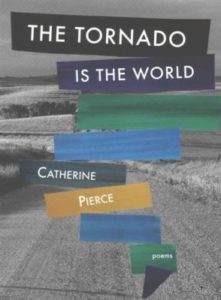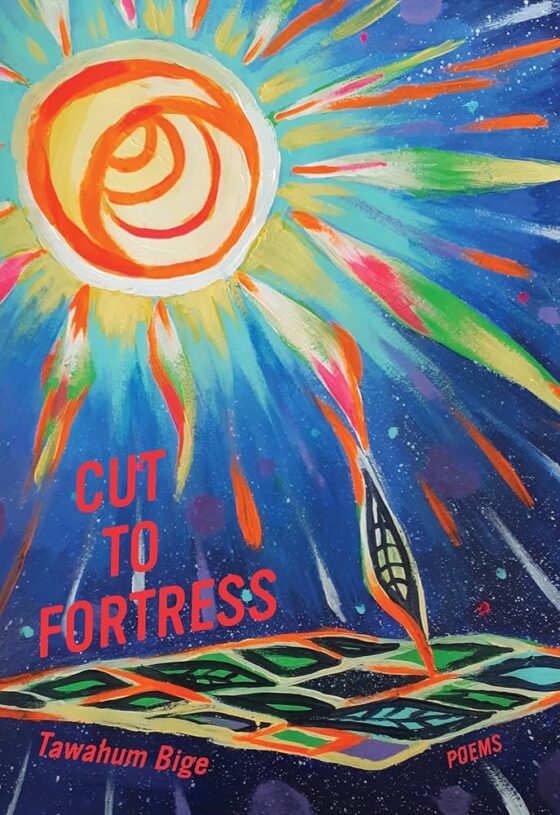
Near the beginning of Catherine Pierce’s The Tornado Is the World, the poem “In the Last Days of the Fever” establishes a lyrical intensity so compelling that, as a reader, I worried it might have come too soon—an act hard for the rest of the book to follow. In this poem, a feverish, sleepless speaker extrapolates catastrophically from her sore throat, which “shrieked like a teakettle,” to “everything that would sting forever. The sharp white/cheddar, the grapefruit juice. Galaxies beyond/my reach.” She considers what’s happening out in “a world… lit and spinning/like a carnival ride.” Delirious, she knows a love for the world so charged that it takes the form of lost faith in the world’s very existence:
And I saw, suddenly, that the whole damn thing
was too beautiful for any of us after all,
that it couldn’t possibly exist, and you’d think
I’d find peace in knowing I wasn’t missing
anything real, but I only wanted it more.
In my fever I flung open the door.
In my fever I stood in the yard and reached,
tried to gather to my burning chest
the whole absurd illusion, the light and motes,
the fake bird cries, the lab-made pine air,
tried to hold tight against me everything
that had never been there at all.
I had no reason to worry. The flip side of this fierce devotion to the world are the fears of losing it, and this book is an ambitious atlas of such fears—their gifts and curses, their contours from dozens of perspectives and in a chorus of voices. Pierce’s poems approach danger from surprising angles. Do you fear the tornado? Then come inside it and hear it speak. Do you fear adult danger and desire? Cast back to adolescence, in a poem like “Heroines,” to remember how exciting it was to imagine. Do you feel threatened by love’s uncertainty? Envision a person you could be, in “Imaginary Vacationer Scenario #1,” who, living alone, fears no loss, “utterly assured” because she “know[s] what the end will be.” Deploying a radical empathy and inspired points of entry, these poems find arresting ways to reverse engineer challenging emotional terrain.
The narrative richness and breadth in Pierce’s third book will come as no surprise to readers familiar with her work. Her previous collection, The Girls of Peculiar, illuminated a complex cultural experience—the anxieties and wants of girls coming-of-age in America in the 80s and 90s—by invoking not one girl but many, in poems that created a strong mesh of subjectivities. In The Tornado Is the World she undertakes a project similarly ambitious in scope, which includes, among other work, three sequences of poems: “imaginary vacation scenario” poems; poems from the perspective of an “unabashed tourist”; and a series of tornado poems comprising the book’s center and centerpiece, the second of its three sections. These poems recount the approach, arrival, and aftermath of a particular disaster in a small town.
Inhabiting the voices of a mother taking cover with her child, a teenager in a car, a dog in the storm’s path, and the funnel itself, the tornado poems derive tension from the way speakers attempt to define themselves and each other amid disaster. Their understandings of themselves frame and re-frame violence and longing. In “The Tornado is Tired of Being a Novelty,” the tornado, speaking of itself in the third person, begins by re-casting its violence as loneliness and desire for power and connection:
What can the tornado do? No one ever says
Take me with you…
Maybe this time
they’ll tip their awestruck faces skyward,
cry out like children to be lifted
and spun.
The need for connection and the impulse to project ones’ own identity onto others are themes that emerge from the various perspectives of these poems. The people dream the tornado apologizes, needing to imagine it possesses a human understanding of what it’s done, and that they can reach it, absolve it. The dog can only perceive the tornado in terms of its own traits, which allows it to say, innocently, as it is swept up, “I hear you howling. You must/ have learned that from me.” In these monologues, misunderstandings concerning the consequences of violence are heartbreaking, from the way the tornado imagines it is embracing the animals (“It will make sure the poor things/know what it is to be held”), to the way the dog greets it without fear, not knowing what it will do: “Hello one-not-like-me. Hello/to your great tail.”
The distinct and often ironic perspectives of the tornado poems also highlight the human impulse to impose our own meanings on the world. The poems interrogate our conventional understandings of forces and feelings outside our control, exposing the ways we reduce them to images that meet our needs. What can the image of the tornado mean? The poem “The Tornado Knows Itself”—in the voice of the tornado—challenges the tendency to romanticize tornadoes, saying that despite how people have tried to define it in the past, “the tornado has no hands, no god, no silvery ribbons.” If it signifies fear, then it is, as the tornado tells the people,
made of buzz saws
and black flies, of the word riddance,
of the moment the teenage boy exposed
himself to the art teacher and couldn’t
explain why, could only cry in shame.
The tornado is made of everything
you can never love, everything you can
never look at without wincing, which is why,
in your naivete, you write it,
sing it, talk it into anything else.
Here the poem self-reflexively exposes and resists its own project: the tornado is identifying the poet’s effort to contain it, to “write it…into” this very poem. The tornado also redefines itself in a way that requires us to reconsider our relationship to fear. It suggests in another poem that that the town needs fear—which “makes life perfect and sharp/ as a shattered plate.”
These questions about meaning-making are an important theme throughout the book. In “Beach Town,” a woman has come to the town intent upon investing it with nostalgia and her own life’s narrative, but the town “won’t cooperate,” calling the images she wants to make of it—the “sunset that reads as redemption”—into question.
Part of what makes the range of voices in these poems so compelling, and the conversation between images so insightfully complicated, is Pierce’s deft lyrical control. A collection teeming with memorable voices is, not surprisingly, distinguished by vivid diction and syntax. Attention to these aspects of craft combines with the strategic use of repetition to create emotionally convincing voices. As a reader, I believe in a callous tornado who longs for adulation, but dismisses attention from self-destructive people by calling them “sad sacks.” The phrase is so mean, establishing the tornado’s coarseness, and it sounds corporeal, heavy even: of course the tornado would think of people as fleshy, physical. It will pick them up, after all, testing their weight along with their value. The repetition creates an authentic music, enacting the urgency of the experience. The funnel cloud is the speed and shape of obsession; repetition in these poems embodies that vicious spinning, underscoring the momentum of anxiety and violence:
But the tornado cannot stop. Will not.
The world cannot stop turning and this minute
the tornado is the world. Cats lift like birds,
trees bullet, everything is collapse,
the tornado has no regrets.
Has no regrets.
Has no regrets.
Meanwhile, back in “Beach Town,” the woman, desperate for a good sign, says to the town, “Come on…just give me something.” The town has much to give, but not what she wants from it—not the beauty she’s asked for, or a reflection of herself she wants confirmed; not what she can contain, control.
The Tornado Is the World gives us disasters and fevers and dark alleys and sudden hawks—all that is wild, dangerous, and leaves us vulnerable and afraid. And what it gives us is somehow more beautiful for refusing to be contained, just as it reminds us how much we love what its wildness threatens to take away. The danger that speaks in so many voices in these poems makes me appreciate both what danger can take from me, and the music and flavor of danger itself. This breathtaking book reminds us to love, feverishly, what it calls the “world-strewn world.”





